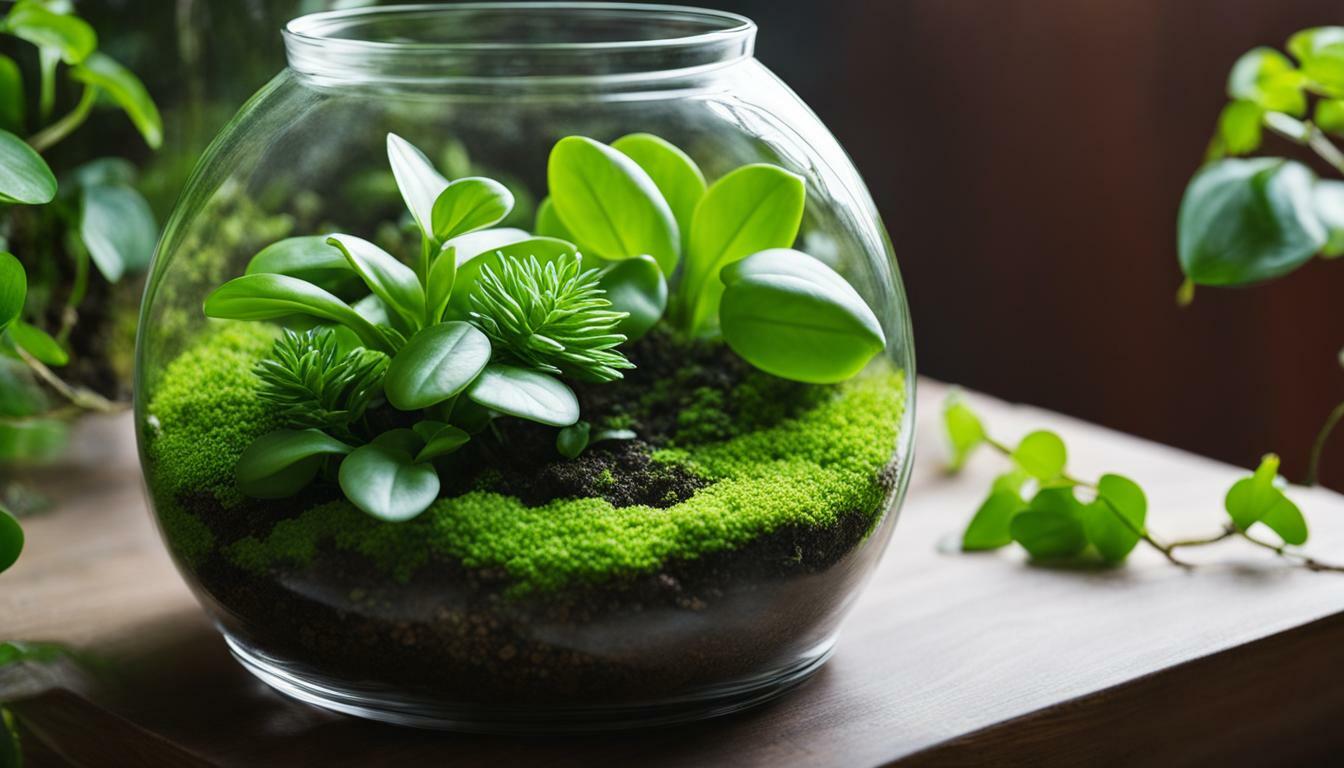Peperomia plants are a versatile and easy-to-grow houseplant that can add zest to indoor or outdoor container arrangements. With their array of foliage colors, shapes, sizes, and textures, peperomias are sure to enhance the beauty of any interior space. Whether grown in terrariums, hanging baskets, or standalone pots, these plants not only bring visual appeal but also contribute to better indoor air quality.
When it comes to caring for peperomias, providing the right conditions is key. They thrive in bright, indirect light and prefer warm temperatures. Moderate to high humidity levels are ideal, and a well-draining potting soil will ensure optimal growth. Watering should be done every seven to ten days, allowing the soil to dry out slightly between waterings. Fertilizing once a month during the growing season will provide the necessary nutrients for healthy foliage.
- Peperomia plants are versatile and easy to grow, suitable for indoor or outdoor container arrangements
- They come in various foliage colors, shapes, sizes, and textures, adding visual interest to any interior space
- Peperomias can be grown in terrariums, hanging baskets, or standalone pots, enhancing the beauty of any setting
- Proper care includes providing bright, indirect light, warm temperatures, moderate to high humidity, and well-draining potting soil
- Water peperomias every seven to ten days, allowing the soil to dry out slightly between waterings
Peperomia Plants: A Beautiful Addition to Your Indoor Space
Peperomia plants are a stunning addition to any indoor space, boasting a wide range of foliage colors, shapes, sizes, and textures. From vibrant greens to variegated patterns, these houseplants add a touch of elegance and life to any room. Whether you prefer small, compact varieties or larger, trailing ones, there is a peperomia plant that will suit your style and space.
“Peperomia plants are like living artworks that can enhance the aesthetic appeal of any interior.”
Not only are peperomias visually appealing, but they also provide numerous benefits as indoor plants. They are known to improve indoor air quality by filtering out toxins and releasing oxygen. This makes them an ideal choice for those looking to create a healthier and more refreshing environment in their home or office.
Table 1: Popular Peperomia Plant Varieties
| Variety | Foliage | Size |
|---|---|---|
| Peperomia obtusifolia | Dark green, glossy | Medium |
| Peperomia clusiifolia | Variegated, heart-shaped | Medium |
| Peperomia prostrata | Tiny, round leaves | Small |
| Peperomia caperata | Wrinkled, textured | Small |
| Peperomia argyreia | Silver-striped, oval | Medium |
To ensure your peperomia plants thrive, it’s important to provide them with the right conditions. They prefer bright, indirect light, so placing them near a window with filtered sunlight is ideal. These plants also appreciate moderate to high humidity levels, making them perfect for bathrooms or kitchens with naturally humid environments.
When it comes to care, peperomias are relatively low-maintenance. Water them every seven to ten days, allowing the top inch of soil to dry out between waterings. Fertilize once a month during the growing season to keep them nourished and healthy.
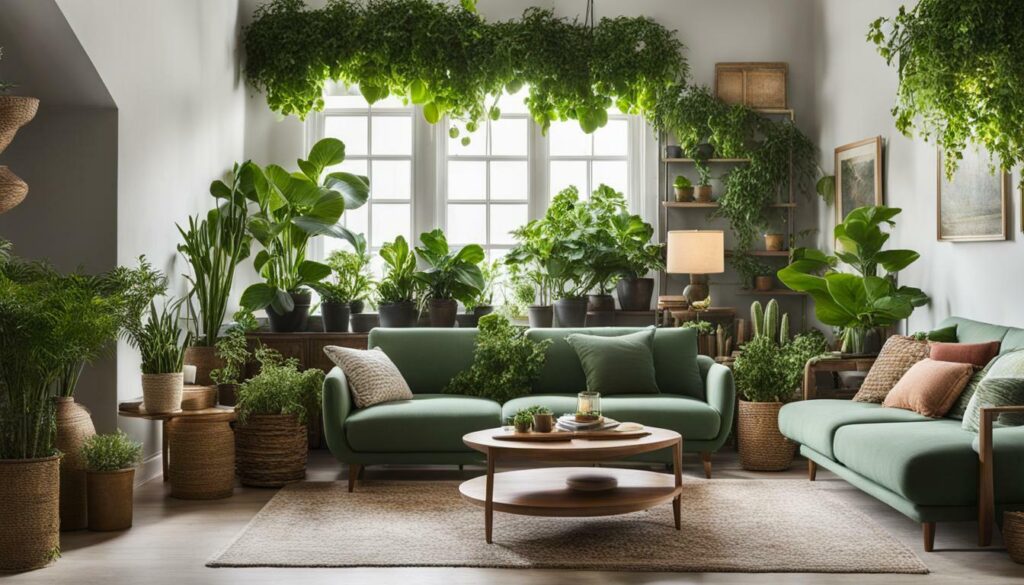
Having peperomia plants in your indoor space is not only visually pleasing but also offers a sense of tranquility and connection to nature. With their beauty, versatility, and air-purifying qualities, these plants are sure to enhance any interior and bring a touch of greenery to your living space.
Creating a Terrarium with Peperomia Plants: Ideas and Inspiration
Terrariums offer a unique and captivating way to showcase peperomia plants, and there are endless possibilities when it comes to terrarium decor and design. Whether you prefer a minimalist aesthetic or a lush, jungle-inspired scene, peperomias can thrive in these enclosed environments, adding a touch of greenery to any space. Let’s explore some creative ideas and inspiration for creating beautiful terrarium displays with peperomia plants.
When designing your terrarium, consider the size and shape of the container. Glass vessels, such as jars or fish tanks, are popular choices as they provide a clear view of your plant collection. You can also experiment with unique shapes like geometric terrariums or hanging glass orbs for a modern twist. Layering different types of peperomias with varying heights and textures creates visual interest and depth within the terrarium.
Enhance the overall appeal of your terrarium by incorporating natural elements like rocks, pebbles, or driftwood. These elements not only add visual interest but also provide texture and serve as a foundation for your peperomia plants. Additionally, consider adding decorative accents such as miniature figurines, fairy lights, or colorful glass beads to personalize your terrarium and make it truly one-of-a-kind.
Terrarium Decor Ideas:
To help you get started, here are some popular terrarium decor ideas:
- Fairy garden-inspired: Create a whimsical terrarium by adding miniature fairy figurines, tiny mushrooms, and delicate moss.
- Desert-scape: Use sandy soil, succulent peperomias, and cacti-like accessories to create a stunning desert-themed terrarium.
- Beach retreat: Incorporate seashells, small pieces of driftwood, and peperomias with trailing vines to evoke a tranquil beach atmosphere.
Remember to take into account the lighting requirements of your peperomias when choosing the placement of your terrarium. Most peperomia plants thrive in bright, indirect light, so avoid placing your terrarium in direct sunlight to prevent scorching the leaves.
With a carefully curated selection of peperomia plants and thoughtful terrarium decor, you can create a miniature garden oasis that brings a touch of nature into your home. Enjoy the creativity and tranquility that terrarium gardening offers, and watch your peperomias thrive in their enchanting little world.
| Terrarium Decor Ideas | Description |
|---|---|
| Fairy garden-inspired | Create a whimsical terrarium by adding miniature fairy figurines, tiny mushrooms, and delicate moss. |
| Desert-scape | Use sandy soil, succulent peperomias, and cacti-like accessories to create a stunning desert-themed terrarium. |
| Beach retreat | Incorporate seashells, small pieces of driftwood, and peperomias with trailing vines to evoke a tranquil beach atmosphere. |
A terrarium is like a miniature world where peperomia plants can thrive and shine. With a bit of creativity and attention to detail, you can create a mesmerizing display that brings nature indoors.
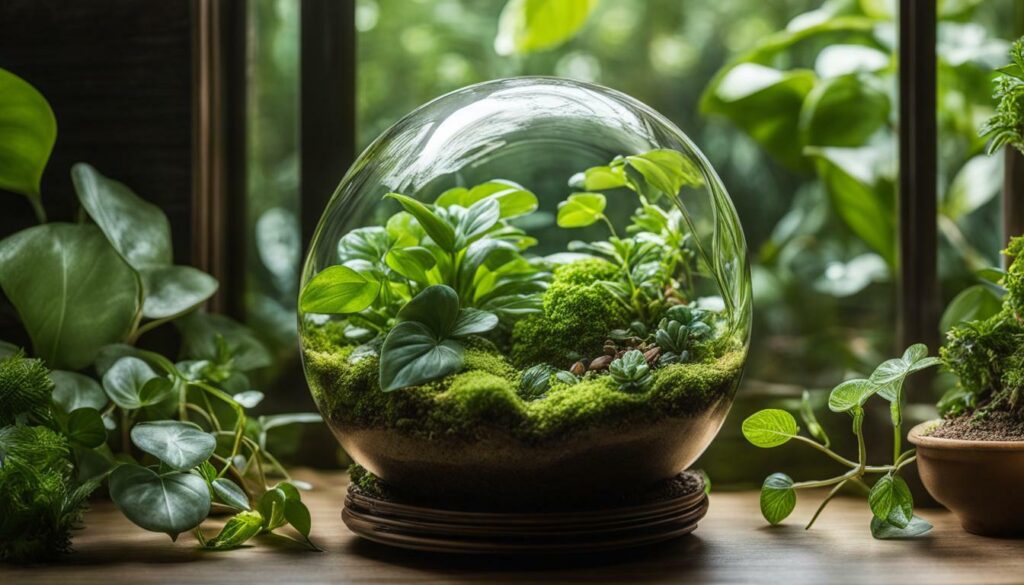
Peperomia plants offer a vast array of choices for plant enthusiasts, with each variety showcasing its own distinct features and charm. Whether you prefer the glossy, heart-shaped leaves of Peperomia obtusifolia, the striking red undersides of Peperomia clusiifolia, or the delicate trailing stems of Peperomia prostrata, there is a peperomia variety to suit every taste and style.
One popular variety is Peperomia caperata, also known as the ripple peperomia, which features textured leaves with deep ridges resembling crumpled paper. It adds a touch of whimsy to any indoor space. Another favorite is Peperomia argyreia, commonly known as the watermelon peperomia, due to its distinctive striped patterns resembling a watermelon rind.
To complete the table, below are a few more peperomia varieties that are worth exploring:
| Peperomia Variety | Description |
|---|---|
| Peperomia obtusifolia | Heart-shaped leaves, glossy and fleshy, available in various shades of green |
| Peperomia clusiifolia | Oval-shaped leaves with vibrant red undersides, adding a pop of color to any collection |
| Peperomia prostrata | Trailing stems adorned with small, rounded leaves, perfect for hanging baskets or terrariums |
| Peperomia caperata | Textured leaves with deep ridges resembling crumpled paper, adding a unique touch to any space |
| Peperomia argyreia | Distinctive striped patterns resembling a watermelon rind, a visual delight for plant enthusiasts |
With such a wide variety of peperomia plants to choose from, you can create a stunning indoor garden filled with an assortment of colors, shapes, and textures. These versatile plants are sure to captivate your attention and bring natural beauty to your home or office.
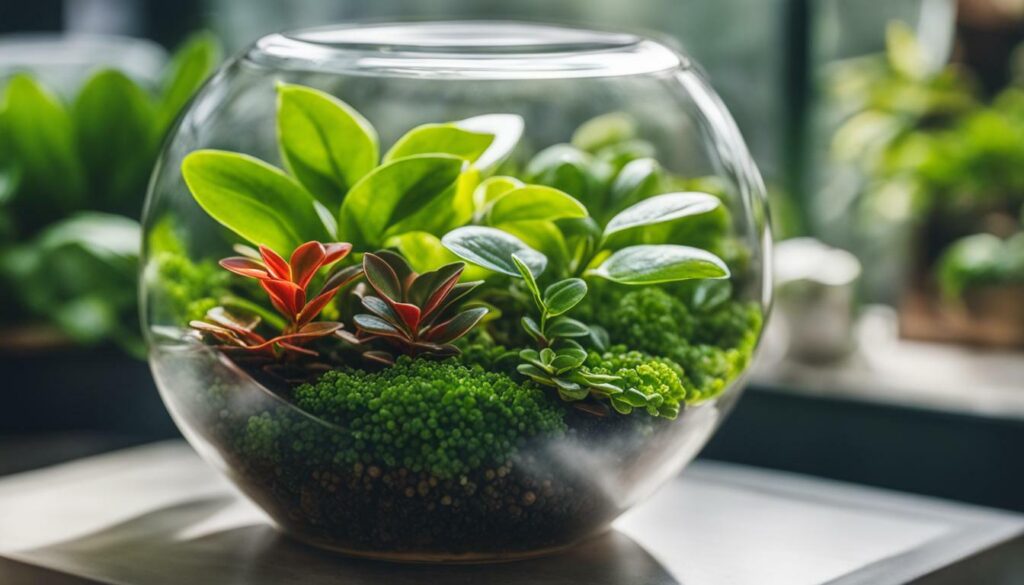
To ensure the health and vitality of your peperomia plants in a terrarium, proper care is essential. Peperomias are relatively low-maintenance plants, but they do have specific needs that require attention. Here are some essential care tips to keep your terrarium plants thriving:
- Light: Peperomias prefer bright, indirect light. Place your terrarium in a location where it will receive plenty of indirect sunlight, such as near a north or east-facing window.
- Temperature: These plants thrive in warm temperatures between 65°F and 75°F (18°C to 24°C). Avoid exposing them to extreme temperature fluctuations.
- Humidity: Peperomias enjoy moderate to high humidity levels. Mist the leaves occasionally or place a small humidity tray filled with water near the terrarium to create a humid microclimate.
- Soil: Use a well-draining potting mix specifically formulated for terrarium plants. This will prevent waterlogged roots and promote healthy growth.
- Watering: Water your peperomia plants every seven to ten days or when the top inch of soil feels dry to the touch. Be sure not to overwater as peperomias are susceptible to root rot.
- Fertilizing: Feed your peperomia plants with a balanced liquid fertilizer once a month during the growing season (spring and summer). Follow the recommended dosage on the fertilizer packaging for best results.
By following these care tips, you can ensure that your peperomia plants thrive in their terrarium environment. Keep in mind that different species of peperomias may have slightly different care requirements, so it’s always a good idea to research the specific needs of your chosen variety.
Pro Tip: Creating a Terrarium with Peperomia Plants
If you’re looking to create a stunning terrarium display using peperomia plants, consider incorporating other terrarium-friendly plants and decorative elements. Mix different textures, heights, and colors to create an aesthetically pleasing arrangement. Here’s an example:
| Plant | Light | Watering | Maintenance |
|---|---|---|---|
| Peperomia Obtusifolia | Indirect light | Every 7-10 days | Low |
| Fittonia (Nerve Plant) | Bright, indirect light | Every 4-7 days | Moderate |
| Selaginella (Club Moss) | Indirect light | Every 3-5 days | Moderate |
| Decorative Rocks | N/A | N/A | Low |
This combination of plants and decorative elements will create a visually appealing terrarium that adds natural beauty to any indoor space. Remember to consider the specific needs of each plant when arranging them in your terrarium, and regularly monitor moisture levels to ensure optimal growth.
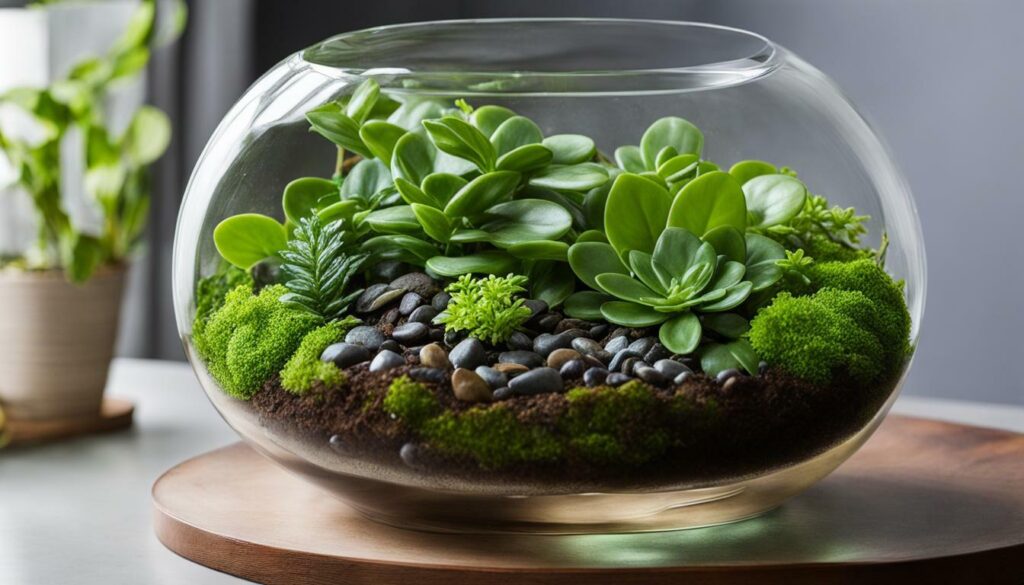
In summary, peperomia plants are a wonderful choice for terrariums due to their versatility and low-maintenance nature. By providing them with the right amount of light, temperature, humidity, soil, watering, and occasional fertilization, you can enjoy a magnificent terrarium display with thriving peperomias as the centerpiece. Follow these care tips and get creative with your terrarium design to create a captivating indoor garden.
Common Care Issues and How to Address Them
While peperomia plants are generally low-maintenance, they can still experience certain care issues that need attention. Being aware of these common problems and knowing how to address them can help ensure the health and vitality of your peperomia plants.
1. Leaves Falling Off: If you notice leaves falling off your peperomia plant, it could be due to overwatering or underwatering. Check the moisture level of the soil and adjust your watering accordingly. Peperomias prefer slightly dry conditions between waterings.
2. Washed-Out Color: If your peperomia leaves appear pale or faded, it may be a sign of insufficient light. Move your plant to a brighter location, but avoid direct sunlight. Peperomias thrive in bright, indirect light.
3. Leggy Growth: Leggy growth occurs when a plant stretches towards a light source. To prevent this, make sure your peperomia receives sufficient light from all angles by rotating it every few weeks. Regular pruning can also help maintain a compact shape.
4. Yellowing Leaves and Brown/Crispy Leaves: Yellowing leaves can indicate either overwatering or underwatering. Adjust your watering schedule accordingly and ensure proper drainage. Brown or crispy leaves can be a sign of low humidity. Increase humidity levels by misting the plant or placing a tray of water nearby.
By addressing these common care issues promptly, you can help your peperomia plants thrive and continue to beautify your indoor space.
Table: Common Care Issues and Solutions for Peperomia Plants
| Common Care Issue | Solution |
|---|---|
| Leaves Falling Off | Check soil moisture and adjust watering |
| Washed-Out Color | Provide brighter, indirect light |
| Leggy Growth | Rotate plant for even light exposure and prune regularly |
| Yellowing Leaves | Adjust watering and ensure proper drainage |
| Brown/Crispy Leaves | Increase humidity levels through misting or placing a tray of water nearby |
Remember that each peperomia plant is unique, and its care requirements may vary slightly. By observing your plants closely and providing the necessary care, you can enjoy the beauty of these versatile and resilient houseplants for years to come.
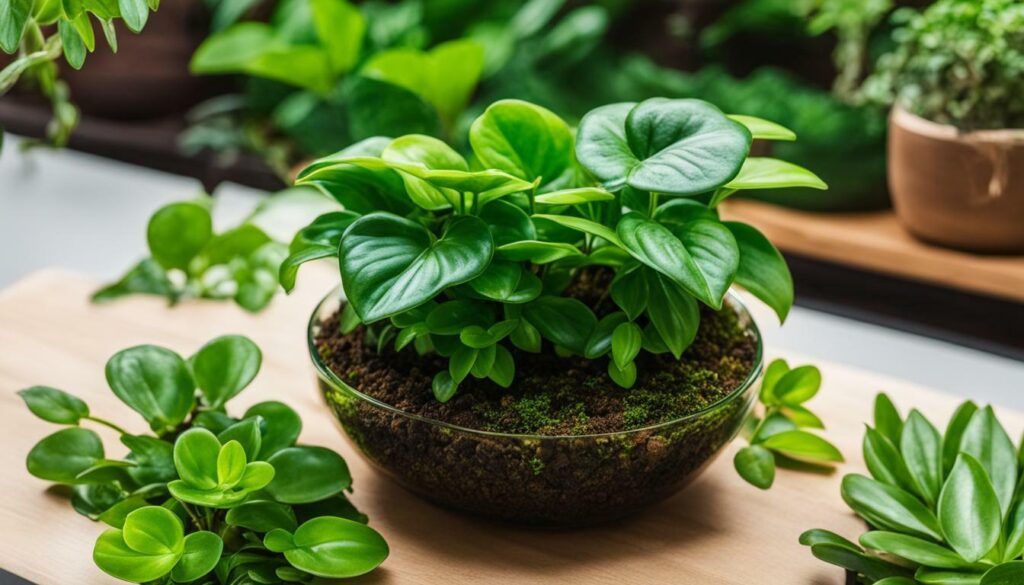
Propagating peperomia plants can be an exciting and rewarding way to grow your collection and share the beauty of these plants with others. Peperomias are known for their ability to propagate easily from stem or leaf cuttings, making them an excellent choice for plant enthusiasts looking to expand their collection.
To propagate peperomia plants, start by selecting a healthy stem or leaf from the parent plant. Using a sharp, clean pair of scissors or pruning shears, make a clean cut just below a leaf node. This is where the new roots will emerge. Remove any lower leaves, leaving only a few at the top to promote new growth.
Place the stem or leaf cutting in a small container filled with moist, well-draining potting soil. Cover the container with a clear plastic bag or place it in a propagator to create a humid environment. Keep the soil consistently moist but not waterlogged to encourage root development. Within a few weeks, you should start to see new roots forming.
Once the new plant has established roots and is showing signs of growth, you can transplant it into a larger container or share it with fellow plant lovers. Remember to provide the new plant with proper care, including bright, indirect light, moderate to high humidity, and regular watering and fertilizing according to the needs of the specific peperomia variety.
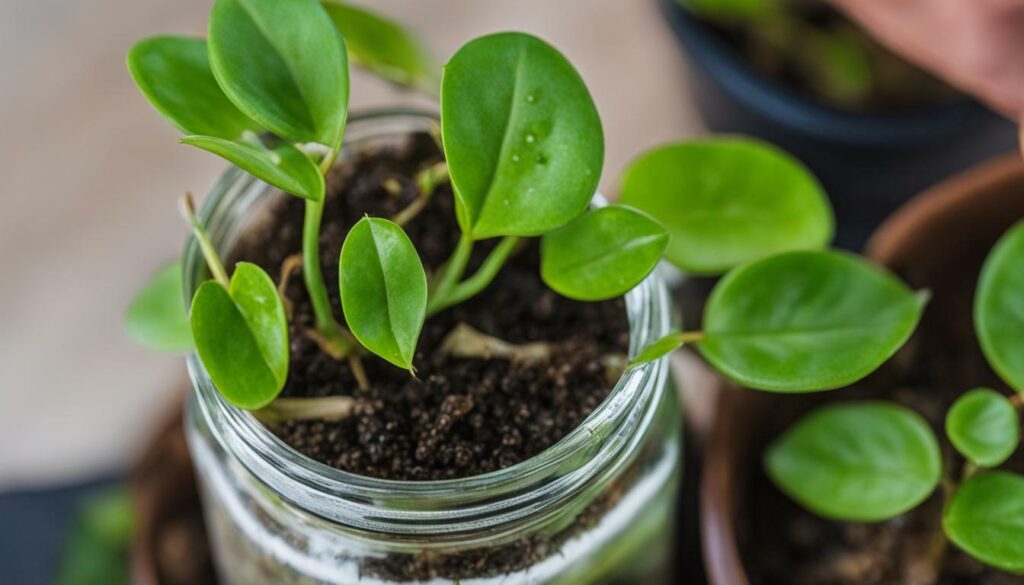
- Choose healthy parent plants with vibrant foliage to ensure the best chance of success.
- Use clean, sharp tools to minimize the risk of introducing pathogens to the cutting.
- Provide a warm and humid environment for the cuttings to promote root development.
- Monitor the moisture levels of the potting soil and adjust watering accordingly; overwatering can cause rot, while underwatering can lead to drying out.
- Be patient and give the cutting time to establish roots before transplanting or sharing.
By following these techniques and providing the proper care, you can enjoy a growing collection of peperomia plants and share the joy of these beautiful and versatile houseplants with others.
| Propagation Method | Skill Level | Success Rate |
|---|---|---|
| Stem Cuttings | Easy | High |
| Leaf Cuttings | Moderate | Medium |
Longevity and Container Considerations for Peperomia Plants
Peperomia plants can live for years in a slightly rootbound container, but proper container selection and care are crucial to their longevity. When choosing a container for your peperomia, opt for one that allows for proper drainage. This will help prevent overwatering, a common issue that can lead to root rot and ultimately affect the plant’s lifespan.
It’s important to note that peperomias prefer to be slightly rootbound. This means that once their root system fills the pot, they will be more prone to reaching their maximum potential growth. However, be mindful not to let the plant become too overcrowded, as this can lead to restricted root growth.
“Peperomia plants can be a delightful addition to any indoor space. Their vibrant foliage and compact size make them perfect for terrariums, hanging baskets, or as standalone plants. With proper care and container selection, these plants can thrive for years, bringing beauty and life to your home.”
Another factor to consider is the type of potting mix used. Peperomias prefer well-draining soil that allows excess water to escape easily. A mix specifically formulated for indoor plants or succulents is ideal, as it provides the right balance of moisture retention and drainage.
| Container Considerations for Peperomia Plants | Longevity Tips for Peperomia Plants |
|---|---|
| Choose a pot with drainage holes to prevent overwatering. | Keep peperomias slightly rootbound to encourage optimal growth. |
| Consider using a potting mix formulated for indoor plants or succulents. | Monitor watering to prevent root rot and promote healthy growth. |
| Ensure the pot is an appropriate size for the plant’s root system. | Provide bright, indirect light to support photosynthesis and vibrant foliage. |
By following these container considerations and providing proper care, you can ensure the longevity of your peperomia plants and enjoy their beauty for many years to come.
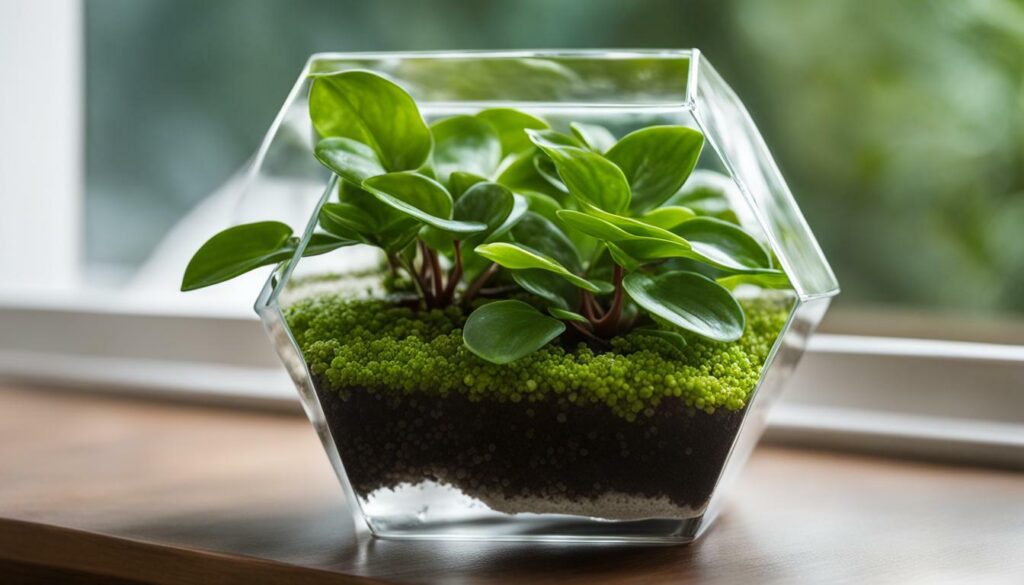
While peperomia plants are generally pest-free, it’s important to be vigilant and take necessary measures to protect them from common pests. These pests can hinder the growth and overall health of your plants if left unchecked. By following a few simple steps, you can ensure that your peperomias stay pest-free and thrive in your indoor space.
To start, regularly inspect your peperomia plants for any signs of infestation. Look for small bugs, webs, or sticky residue on the leaves. If you spot any pests, isolate the affected plant immediately to prevent the infestation from spreading. For small infestations, you can use a soft cloth or cotton swab dipped in rubbing alcohol to remove the pests manually. Be sure to clean both the upper and lower surfaces of the leaves, as pests can hide in hard-to-reach areas.
If the infestation is more severe or persists despite manual removal, consider using organic pest control methods. Neem oil, insecticidal soap, or horticultural oil can effectively eliminate pests while being safe for your peperomia plants. Follow the instructions on the product’s label for proper application.
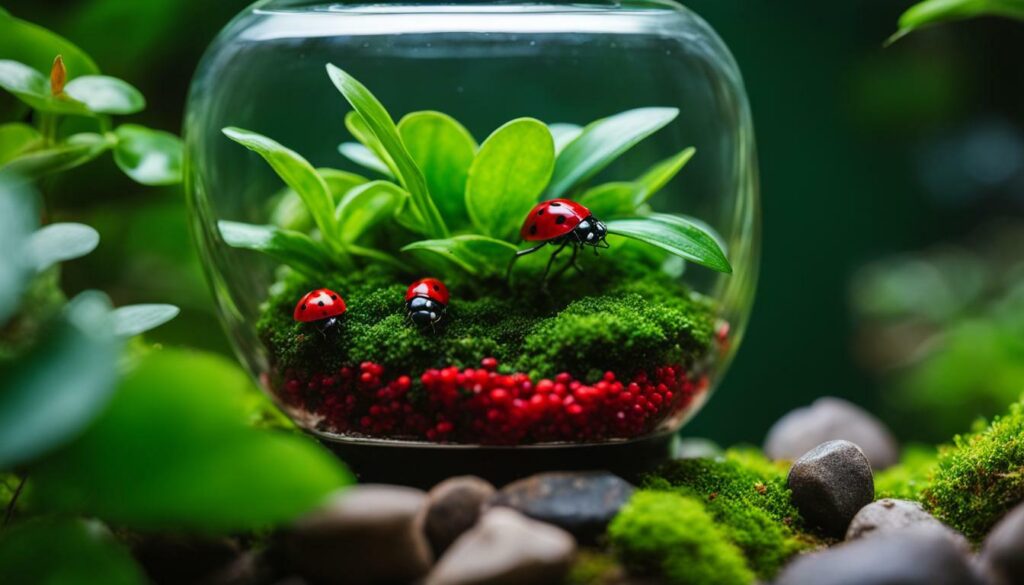
Prevention is key in maintaining pest-free peperomia plants. Avoid overwatering your plants, as excessive moisture can attract pests. Ensure that the soil is well-draining and allow the top inch of soil to dry between waterings. Additionally, keep your indoor space clean and free of debris, as pests can hide in fallen leaves or other organic matter. Properly ventilate the area to improve air circulation, and avoid overcrowding your peperomia plants, as this can create a favorable environment for pests.
By being proactive in managing pests and providing optimal growing conditions for your peperomia plants, you can enjoy their beauty and lush foliage for years to come. Remember to regularly monitor your plants, address any issues promptly, and provide them with the care they need. With a little effort, your peperomias will continue to thrive and enhance your indoor space.
Conclusion
By following the provided care tips and tricks, you can create an enchanting terrarium display with thriving peperomia plants that bring life and beauty to your indoor space. Peperomia plants are versatile and easy-to-grow, making them a popular choice among plant enthusiasts. With their various foliage colors, shapes, sizes, and textures, peperomias add zest to any indoor or outdoor container arrangement.
Whether you prefer to showcase them in terrariums or hanging baskets, peperomias can thrive in a range of environments. Not only do they enhance the aesthetic appeal of your indoor space, but they also contribute to improved indoor air quality.
For optimal growth, peperomias prefer bright, indirect light and warm temperatures. They thrive in moderate to high humidity levels and require well-draining potting soil. Watering every seven to ten days and monthly fertilizing during the growing season will help sustain their health and vibrancy.
While peperomia plants are generally pest-free, it’s essential to watch out for mealybugs, whiteflies, and spider mites. These common pests can be effectively managed with the proper care and attention.
With popular varieties like Peperomia obtusifolia, Peperomia clusiifolia, Peperomia prostrata, Peperomia caperata, and Peperomia argyreia, there’s a peperomia plant for every plant enthusiast’s taste and preference.
Remember to address common care issues such as leaves falling off, washed-out color, leggy growth, yellowing leaves, and brown or crispy leaves promptly to ensure the continued health and vitality of your peperomias. Propagating peperomia plants from stem or leaf cuttings is also a great way to expand your collection and enjoy the beauty of these plants for years to come.
By selecting a slightly rootbound container and providing adequate light and humidity, you can extend the longevity of your peperomia plants. Be attentive to signs of overwatering or underwatering, as these can impact their overall health and well-being.
With proper care and attention, peperomia plants can live for years, adding charm and freshness to your indoor space. So, embark on your peperomia plant journey and enjoy the rewards of nurturing these delightful plants that bring life and beauty into your home.
What Care Tips Do Peperomia Plants Have in Common with Ferns for Thriving in a Terrarium?
Peperomia plants and ferns both thrive in a terrarium by requiring similar care tips. Both growing terrarium plants, ferns and peperomias need high humidity and indirect light. They also prefer well-draining soil and regular misting. These common care requirements make them ideal companions in a terrarium setting.
FAQ
How often should I water my peperomia plant?
Peperomia plants should be watered every seven to ten days, allowing the soil to dry out slightly between waterings.
What kind of light do peperomia plants prefer?
Peperomia plants prefer bright, indirect light. Avoid placing them in direct sunlight, as it can scorch their leaves.
How often should I fertilize my peperomia plant?
Peperomia plants should be fertilized once a month during the growing season using a balanced houseplant fertilizer.
What are common care issues with peperomia plants?
Common care issues include leaves falling off, washed-out color, leggy growth, yellowing leaves, and brown or crispy leaves.
How can I propagate peperomia plants?
Peperomia plants can be propagated from stem or leaf cuttings. Simply place the cuttings in moist soil or water until roots develop.
What should I do if my peperomia plant gets infested with pests?
If your peperomia plant gets infested with pests such as mealybugs, whiteflies, or spider mites, you can use insecticidal soap or neem oil to manage the infestation. Regularly inspect your plant for signs of pests and take immediate action.
How long can peperomia plants live in a container?
Peperomia plants can live for years in a slightly rootbound container. It is important to choose a container that is not too large and provides adequate drainage.
What are some popular varieties of peperomia plants?
Some popular varieties of peperomia plants include Peperomia obtusifolia, Peperomia clusiifolia, Peperomia prostrata, Peperomia caperata, and Peperomia argyreia.
Can peperomia plants be grown in terrariums?
Yes, peperomia plants can be grown in terrariums. They thrive in the humid environment provided by terrariums and can enhance the overall beauty of the display.
How can I improve the humidity for my peperomia plant?
Peperomia plants like moderate to high humidity. You can improve humidity levels by placing a tray of water near the plant, using a humidifier, or misting the leaves with water.

